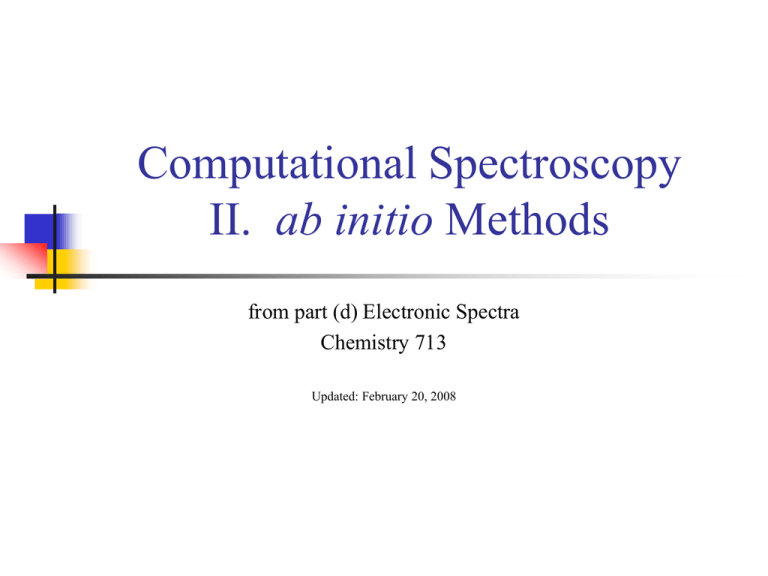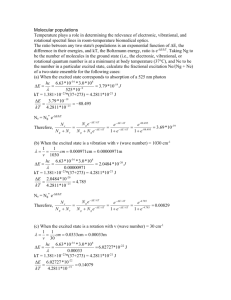Computational Spectroscopy
advertisement

Computational Spectroscopy
II. ab initio Methods
from part (d) Electronic Spectra
Chemistry 713
Updated: February 20, 2008
The Born-Oppenheimer Approximation
QuickTime™ and a
decompressor
are needed to see this picture.
For a given molecular geometry (i.e., fixed nuclear
coordinates, R), solve the electronic Schroedinger equation:
H e e,n r;R E n R e,n r;R
QuickTime™ and a
decompressor
are needed to see this picture.
where He is the whole molecular Hamiltonian except the
nuclear kinetic energy and r represents the coordinates for
all of the electrons, and e is the electronic wave function.
Repeat for a range of molecular geometries R of interest to
construct a potential energy surface.
The electronic energy En(R) is the potential energy in
which the nuclei move.
Up to now we have just been concerned about the lowest
energy electronic state, n=0.
To deal with electronic (UV/vis) spectroscopy, we also
need to know some of the higher electronic surfaces (n=1,
2, …) as well.
The nuclear motion on each surface can then be solved as a
separate step.
F.F. Crim, Spectroscopic probes and vibrational state control of chemical reaction dynamics in gases and liquids.
Talk WA04, International Symposium on Molecular Spectroscopy, Columbus OH, 2006.
http://molspect.chemistry.ohio-state.edu/symposium_61/symposium/Program/WA.html#WA04
The Franck-Condon Principle
In a diatomic molecule, the potential
energy curves are different for lower and
upper electronic states.
h
re
The bond length re changes
The vibrational frequency changes.
Use double prime for lower state (), and
single primes for upper state ().
re
h
r
Gordon M. Barrow, An Introduction to Molecular Spectroscopy,
McGraw-Hill, New York, 1962, fig. 10-1, p. 232.
Iodine oxide (IO)
Potential energy curves
There are many potential energy curves even in a
small molecule.
Curves of the same symmetry don’t cross:
Some are attractive;
others are repulsive
“adiabatic” curves
Some result from the crossing of “diabatic” curves, and
as a result have peculiar shapes.
Notation:
“X” denotes the ground state
Upper case letters, A, B, etc., indicate excited states of
the same spin multiplicity as the ground state.
Lower case letters, a, b, c, etc., indicate excited states of
a different multiplicity. (Numbers are not normally used.)
The symmetry and spin multiplicity of the state are
indicated by a term symbol, such as 2, 4–, etc.
S. Roszak, M. Krauss, A. B. Alekseyev, H.-P. Liebermann, and R. J. Buenke,
J. Phys. Chem. A, 104 (13), 2999 -3003, 2000. 10.1021/jp994002lr, Fig. 1.
The Franck-Condon Principle
Electronic transitions are “vertical”, that is the nuclei
don’t move while the electron(s) are being excited.
Because the upper state wavefunctions are shifted from
those in the ground state and because the vibrational
frequencies are different, changes in the vibrational
quantum number accompany the electronic excitation.
The relative intensities of the vibrational subbands
vv are given by the squares of overlap integrals,
2
called Franck-Condon factors:
v v
If neither the bond length, nor the vibrational frequency
change, then the selection rules are v=0.
In polyatomic molecules, vibrational progressions
occur in vibrational
modes for which either the
equilibrium position is changes or the frequency is
changed.
The Franck-Condon Principle:
Polyatomic molecules
Benzene
A spectrum with vibrational progressions
Band
Origin
Franck-Condon
envelope
45,000
Wavenumber / cm-1
37,000
J. M. Hollas, High resolution Spectroscopy, Butterworths, London, 1982, p 393.
In polyatomic molecules, vibrational
progressions occur in vibrational modes for
which either the equilibrium position is
changes or the frequency is changed.
Therefore, a typical electronic band has a lot of
vibrational structure, which extends over a few
thousand cm-1.
The band origin is the frequency of the
v=00 band. The band origins of electronic
transitions are what we can most easily
calculate with ab initio methods.
For large molecules or in the condensed phase,
the vibrational structure is heavily overlapped
and merges together into a wide unstructured
blob (the Franck-Condon envelope).
Selection rules
for electronic spectroscopy
Spin multiplicity is conserved.
Changes in vibrational motion follow the FranckCondon Principle
Rotational transitions (J=0,1, K=0,1)
accompany each electronic+vibrational (vibronic)
transition.
For molecules with a center of symmetry, the g/u
symmetry changes.
Nuclear spin states are conserved.
Additional rules apply in particular cases.
The fate
of electronically excited molecules
1.
Jablonski diagram
2.
Fluorescence: a visible or UV photon is emitted
to return the molecule to its ground state.
Intersystem crossing: radiationless conversion of
the energy back to a state of different spin
multiplicity. (e.g., singlet to triplet).
-
3.
4.
Internal conversion: radiationless conversion of
the energy back to the ground state (or other state
of the same spin multiplicity).
A Photochemical reaction
-
5.
J. I. Steinfeld, Molecules and Radiation, MIT Press, Cambridge, MA, 2nd ed, 1985, p 287.
Occasionally followed by phosfluorescence:
emission of a photon with a change in the spin
multiplicity. (VERY weak; a long radiative
lifetime.)
photodissociation, isomerization
Energy transfer to a nearby molecule
Conical intersections
Two electronic surfaces can
met like two cones touching
tip to tip.
Widespread throughout
electronic spectroscopy.
Act like a sink-hole that
allows the system to drop
through onto a lower surface.
Action spectra can be recorded
by detecting photofragments.
Note that only two of the six
vibrational coordinates are
represented in this diagram!
QuickTime™ and a
decompressor
are needed to see this picture.
h
QuickTime™ and a
decompressor
are needed to see this picture.
F.F. Crim, Spectroscopic probes and vibrational state control of
chemical reaction dynamics in gases and liquids. Talk WA04,
International Symposium on Molecular Spectroscopy, Columbus
OH, 2006.
Conical intersection
Electronic excitations
in the orbital approximation
a
N/2
For electronically excited states, one or more electrons is in an orbital with
higher than the lowest possible energy allowed by the Pauli principle.
Given M doubly occupied molecular orbitals, and N unoccupied orbitals
(N), there are an enormous number of possible excited electronic states.
Consider cases where the ground state is closed shell, and can be represented
by a single Slater determinant: 1
0 122232 ...N2 / 2
An electron in the highest occupied molecular orbital (HOMO) N/2 is
excited to a higher orbital, a:
Na / 2 122232 ...N / 2a
A singly occupied orbital with no bar is spin up; one with a bar is spin down.
The excited singlet state
(S=0) is linear combination of two Slater
determinants: 1 a
N / 2 12 12 22 32 ... N / 2a 12 22 32 ... N / 2 a
The corresponding triplet state (S=1) has three components and is somewhat
lower in energy:
3 a
N / 2;Ms 1 12 22 32 ...N / 2a
3
3
...
Na / 2;M
s
0
Na / 2;M
s
1
12 22 32... N / 2 a
1
2
2
1
2
2
2
3
a 12 22 32 ...N / 2 a
N/2
Quick review of
Slater determinants
Example: the ground state of lithium. The term symbol for Li is 2S.
“S” means orbital angular momentum L=0; “2” indicates a doublet state,
1
1
that is the spin orbital angular momentum, S 12 and M S 2 , 2
One component of the doublet is
0 1s2 2s
2
2s1
1s1 1s1
1
1s2 1s2 2s2
3!
1s3 1s3 2s3
{1s11s22s3 1s12s21s3 1s11s22s3
1s12s21s3 2s11s21s3 2s11s21s3}
1
6
The other component of the doublet is
0 1s22s
2
1s1 1s1 2s1
1
1s2 1s2 2s2
3!
1s3 1s3 2s3
The Pauli principle requires that
the overall wavefunction be
antisymmetric with respect to
the interchange of ANY two
electrons.
Since determinants change sign
upon the interchange of any two
rows or columns, we will set-up
our multi-electron
wavefunctions as determinants.
HOMO and LUMO
molecular orbitals
HOMO = Highest Occupied Molecular Orbital
LUMO = Lowest Unoccupied Molecular Orbital
LUMO
*
3.44531 eV
Pyridine
RHF/6-31G*
Excite an electron from
the HOMO to the LUMO
HOMO
-9.6324 eV
LUMO-HOMO = 13.08 eV = 105,500 cm-1
Observed AX band is at 34,769 cm-1
LUMO+1
*
3.82487 eV
LUMO+2
*
6.51981 eV
Difficulties
with the Simplest Orbital Picture
Phenyl nitrene
QuickTime™ and a
decompressor
are needed to see this picture.
The qualitative picture on the previous slide is very
appealing.
Calculated Energies of excited states and transition
frequencies are much too large in the orbital
approximation.
We must realize that the other electrons readjust their
motions to accommodate the excited electron, thereby
minimizing the total energy of the excited state.
If we use the variation method to re-optimize the
excited state, then our calculation will often collapse
back to the ground state.
Cramer, p 495.
Gives our band descriptions as *, etc.
The excited state must be kept orthogonal to the ground
state.
Realize that excited states are more sensitive to basis set
limitations.
Sometimes a change of symmetry or spin upon excitation
will prevent the variational collapse of the excited state.
In favorable circumstances, the HF or DFT levels can be
applied.
CI Singles (CIS) for Excited States
Based on the Hartree-Fock (HF) ground state and
configuration interaction with single electron
excitations.
With M occupied orbitals from which an electron could
be excited and N possible excited orbitals that it could
be promoted to gives MN interacting determinants.
Resulting wavefunctions are of approximately HF
quality (meaning not really as good as we would like).
Can optimize excited state geometries and find excited
state vibrational frequencies.
CIS and CIS(D) are available in Spartan and in
Gaussian.
CIS excited state calculations
with Spartan (04 or 06)
1. Optimize the ground state geometry at
a suitable level (e.g., RHF/6-31G*)
2. At that geometry, run a single point
excited state calculation (CIS or
CIS(D)) to get the “vertical” UV
spectrum (figure at right).
3. To get the excited state geometry and
properties, optimize at the CIS
level.
acrolein
QuickTime™ and a
decompressor
are needed to see this picture.
QuickTime™ and a
decompressor
are needed to see this picture.
Acrolein UV/Vis by CIS
Excited state optimized geometry: CIS/6-31G*
C=C 1.510 A
C-C 1.432 A
C=O 1.209 A
Dipole moment: 0.65 Debeye
QuickTime™ and a
decompressor
are needed to see this picture.
“vertical”
spectrum
Ground state: RHF/6-31G*
C=C 1.321 A
C-C 1.478 A
C=O 1. 190 A
Dipole moment: 3.5 Debeye
QuickTime™ and a
decompressor
are needed to see this picture.
single
bond!
/ nm
Spartan06 2min 21 sec for excited state calculation
Acrolein
excited state vibrations by CIS
What we would really
like is not an excited
state IR spectrum but
the Franck-Condon
frequencies and
intensities for the
UV/Vis spectrum.
Note that the calculated
ground state frequencies
at the RHF/6-31G* level
are systematically TOO
HIGH.
QuickTime™ and a
decompressor
are needed to see this picture.
Excited State Vibrations
(IR spectrum not easily accessible by experiment)
QuickTime™ and a
decompressor
are needed to see this picture.
Ground State Vibrations
Acrolein
excited state vibrations by CIS
Two of the low frequency out-of-plane modes are imaginary.
Implies that the excited state structure is non-planar, even though the ground state is planar.
The planar (CS) structure that we found is a saddle point between two equivalent non-planar minima.
Therefore calculation of the vibrational frequencies is not valid.
Spartan calculates vibrational frequencies in the excited state, but does not calculate the FranckCondon intensities.
Repeating the calculation with the “symmetry” box unchecked did not help, so we need to start with a
non-planar initial structure.
SPARTAN
QuickTime™ and a
decompressor
are needed to see this picture.
Acrolein
excited state vibrations by CIS
To get a starting geometry with
non-planar C=CH2, I had to redraw
the structure from scratch.
Convergence of the excited state
geometry at the CIS/6-31G* level
took much longer: 18 steps and 10
minutes.
Spartan did not recognize the ground
state as acrolein and did not calculate
a correct excited state spectrum.
The non-planar structure gives all real
vibrational frequencies.
Both planar and non-planar excited
states predict a reduction of the C=O
frequency and a slight increase in the
aldehyde hydrogen, which is the
strongest CH stretch.
QuickTime™ and a
decompressor
are needed to see this picture.
single bond
NON-PLANAR Excited state
QuickT
deco
are needed to
QuickTime™ and a
decompressor
are needed to see this picture.
Excited State Vibrations
PLANAR
QuickTime™ and a
decompressor
are needed to see this picture.
Ground State Vibrations
Time-dependent DFT (TDDFT)
Based on calculating the polarization of the
ground state molecule produced by an
oscillating light field.
Excited state wavefunctions, geometries and
frequencies are not explicitly determined.
Good for calculating UV/visible spectra,
especially for low-lying excited states.
Difficulty with high lying states and for
charge-transfer states.
Available in Gaussian and Spartan.
TDDFT excited state
calculation with Spartan
Do a single point
energy calculation …
… with a geometry
that you previously
optimized at the
same DFT level
for the ground state.
Energy
QuickTime™ and a
decompressor
are needed to see this picture.
Acrolein UV/Vis by TDDFT
UV/Vis spectrum is much better than with CIS.
As you would expect, the ground state IR spectrum is also much better with DFT than in the HF
calculation that we used as a starting point for the CIS calculation.
But we did not get the excited state geometry, dipole moment, or vibrational frequencies.
Spartan claims that it will not optimize the excited state geometry, but it might if you are willing to
let it compute for days.
TDDFT B3LYP/6-31G*
QuickTime™ and a
decompressor
are needed to see this picture.
Spartan06: 2 min, 7 seconds plus 3 min 24 sec for B3LYP/6-31G* geometry optimization
Comparison of Spartan
excited state calculations
CIS:
TDDFT
UV/Vis spectra with 6-31G* basis not very accurate.
The CS Excited state geometry was reasonable.
Does not find excited states with lower symmetry than the ground state.
Calculation produced widely varying excited state dipole moments results for the
same final structure.
Spartan does not represent the excited stated orbitals in intelligible form.
CIS(D) is also available and might give a more accurate UV/Vis spectrum.
Reasonably accurate UV/Vis spectrum
Other excited state properties not calculated
ZINDO
A semi-empirical of calculating electronic spectra.
Available in G03, but not in Spartan.
Higher level methods
for excited states
MCSCF - multi configuration self-consistent field
CASPT2 - Complete active space with electron
correlation treated perturbatively.
MRCI (including MRCISD) multi reference
configuration interaction (with single and double
excitations).
All of these are multi-reference methods.
QuickTime™ and a
decompressor
are needed to see this picture.
QuickTime™ and a
decompressor
are needed to see this picture.
F.F. Crim, Spectroscopic probes and vibrational state control of chemical
reaction dynamics in gases and liquids. Talk WA04, International
Symposium on Molecular Spectroscopy, Columbus OH, 2006.
Cramer p 459




